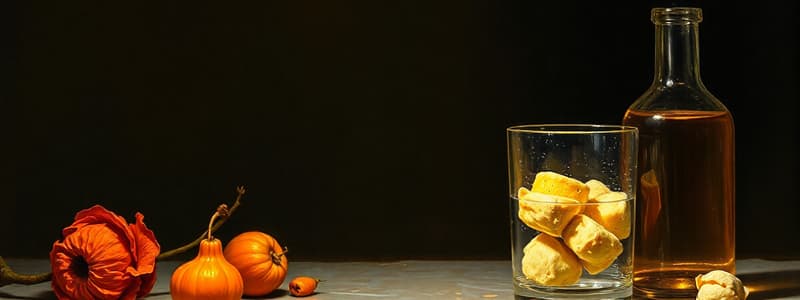Podcast
Questions and Answers
What is the purpose of Molisch's test?
What is the purpose of Molisch's test?
- To confirm the presence of carbohydrates (correct)
- To detect the presence of disaccharides
- To identify monosaccharides only
- To test for reducing agents in proteins
What color indicates a positive result in Barfoed's test?
What color indicates a positive result in Barfoed's test?
- Red precipitate (correct)
- Green precipitate
- Purple ring
- Brown precipitate
Which of the following is true about the action of heat on carbohydrates?
Which of the following is true about the action of heat on carbohydrates?
- It solidifies sugars instantly
- It may lead to caramelization (correct)
- It does not change the flavor of sugars
- It results in the formation of monosaccharides
What is the role of concentrated sulfuric acid in Molisch's test?
What is the role of concentrated sulfuric acid in Molisch's test?
What distinguishes monosaccharides from disaccharides during Barfoed's test?
What distinguishes monosaccharides from disaccharides during Barfoed's test?
What is the purpose of Barfoed’s reagent in the test described?
What is the purpose of Barfoed’s reagent in the test described?
What characteristic of ketoses distinguishes them from aldoses in Seliwanoff’s test?
What characteristic of ketoses distinguishes them from aldoses in Seliwanoff’s test?
What is an expected observation when performing Fehling’s test on reducing sugars?
What is an expected observation when performing Fehling’s test on reducing sugars?
What happens if disaccharides are boiled for more than 2 minutes in the Barfoed’s test?
What happens if disaccharides are boiled for more than 2 minutes in the Barfoed’s test?
What is the deep cherry red color produced in Seliwanoff’s test a result of?
What is the deep cherry red color produced in Seliwanoff’s test a result of?
Flashcards
Reducing Monosaccharides vs. Disaccharides
Reducing Monosaccharides vs. Disaccharides
Differentiate between reducing monosaccharides and disaccharides based on the time taken for precipitate formation during a chemical reaction.
Seliwanoff's Test
Seliwanoff's Test
A test used to differentiate between ketose and aldose sugars based on their reaction rate with a specific reagent.
Fehling's Test
Fehling's Test
A chemical test to identify reducing sugars, which have a free carbonyl group (aldehyde or ketone).
Reducing Sugars
Reducing Sugars
Signup and view all the flashcards
Barfoed's Test
Barfoed's Test
Signup and view all the flashcards
Molisch's Test
Molisch's Test
Signup and view all the flashcards
Reducing Monosaccharides
Reducing Monosaccharides
Signup and view all the flashcards
Disaccharides
Disaccharides
Signup and view all the flashcards
Caramelization
Caramelization
Signup and view all the flashcards
Study Notes
Qualitative Identification of Carbohydrates
-
Physical Properties: Color, shape, and solubility are physical characteristics used to identify carbohydrates.
-
Chemical Properties (Specific Tests): Various chemical tests are used to confirm the presence and type of carbohydrate.
Molisch's Test
- General Test for Carbohydrates: A test for almost all types of carbohydrates.
- Reaction Process: Concentrated sulfuric acid converts the carbohydrate into furfural or its derivative. This product then reacts with α-naphthol to produce a purple-colored compound.
- Procedure:
- Add 2mL of the sample solution to a clean test tube.
- Add 2-3 drops of Molisch reagent slowly.
- Carefully add concentrated sulfuric acid down the side of the test tube.
- Observe the formation of a violet ring at the junction of the two layers. A violet ring confirms the presence of carbohydrate.
Action of Heat on Sugars
- Caramelization: When sugars are heated, they undergo caramelization, a process that breaks them down and forms new compounds, changing the color and flavor of the food.
- Observation: Heating solid sugars will produce a change in appearance, with an odour of burnt sugar.
Barfoed's Test
- Detects Monosaccharides: Specifically designed to distinguish between reducing monosaccharides (which are sugars containing an aldehyde or ketone group) and disaccharides.
- Reagent: A mixture of ethanoic (acetic) acid and copper(II) acetate is used.
- Procedure: Test solution is mixed with Barfoed's reagent and boiled. The presence of a reducing monosaccharide is confirmed by the formation of a red copper(II) oxide precipitate. Disaccharides do not produce this precipitate as quickly.
Principle of Barfoed's Test
- Reaction Time: Monosaccharides react relatively quickly (within 1-2 minutes), while disaccharides take longer (7-8 minutes).
- Hydrolyzation: Disaccharides first need to undergo hydrolysis (breaking down) into monosaccharides before the reaction takes place.
- Precipitate Appearance: The appearance of a red precipitate confirms the presence of reducing monosaccharide.
Seliwanoff's Test
- Differentiates Ketoses and Aldoses: A timed color reaction to distinguish sugars with a ketone group (ketoses) from those with an aldehyde group (aldoses). The test is specific for ketohexoses (ketoses with six carbon atoms).
- Resorcinol and HCl: The test reagent contains resorcinol and concentrated HCl.
- Dehydration: Ketoses undergo dehydration faster than aldoses in the presence of the concentrated acid, resulting in a deeper cherry-red color produced.
- Procedure: Add 1mL of the test sample and 1mL of distilled water to separate tubes. React each solution with Seliwanoff's Reagent. Observe the formation of color in a water bath.
Fehling's Test
- Identifying Reducing Sugars: Used to differentiate reducing sugars (containing a free aldehyde or ketone group) from non-reducing sugars.
- Fehling's Solution: Contains copper(II) sulfate, potassium sodium tartrate and strong alkali (usually sodium hydroxide)
- Reaction with Reducing Sugars: Reducing sugars react with Fehling's solution, causing the copper ions to reduce to copper(I) oxide (Cu2O) which appears as a red precipitate.
Studying That Suits You
Use AI to generate personalized quizzes and flashcards to suit your learning preferences.
Related Documents
Description
This quiz focuses on the qualitative methods used for identifying carbohydrates, including physical and chemical properties. It covers specific tests such as Molisch's Test, including its procedure and reactions. Participants will also learn about the action of heat on sugars and caramelization.




